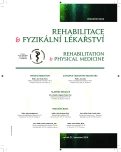Electroencephalographic Correlates of the Onset of Central Fatigue During Prolonged Violin Play of Professional Musicians
Authors:
Z. Brabencová 1; D. Pánek 1; D. Pavlů 1; L. Kovářová 2
Authors‘ workplace:
Katedra fyzioterapie FTVS, Univerzita Karlova v Praze, vedoucí katedry doc. PaedDr. D. Pavlů, CSc.
1; Laboratoř sportovní motoriky FTVS, Univerzita Karlova v Praze, vedoucí laboratoře Mgr. J. Baláš, Ph. D.
2
Published in:
Rehabil. fyz. Lék., 21, 2014, No. 4, pp. 187-193.
Category:
Original Papers
Overview
The aim of this work is to verify the presence of alpha activity in the electroencephalographic recording during prolonged (20 minute) violin play and compare its morphological and topical parameters with the native EEG record before and after the performance. Research sample consisted of five violinists at the age range of 25-60 years. The results showed the occurrence of alpha activity for three of five probands, in one case with a very low incidence. There have also been demonstrated changes in the distribution of alpha activity from parietooccipital areas before the performance to central areas during the play and immediately after finishing. All probands showed increased amplitude of the alpha activity immediately after finishing. The obtained results confirm the changes of morphology and the changes of topic alpha activity during cognitive activities and at the onset of central fatigue during physical activity described in literature. These changes were demonstrated by increasing the amplitude of alpha activity and the shift from parietooccipital areas to central areas.
Keywords:
EEG, alpha activity, violin performance, brain mapping
Sources
1. AMBLER, Z.: Neurologie pro studenty lékařské fakulty. 5. vyd., Praha, Karolinum, 2004, 399 s., ISBN 80-246-0894-4.
2. BAILEY, STEPHEN P. et al.: Changes in EEG during graded exercise on a recumbent cycle ergometer, Journal of Sports Science and Medicine, 7, 2008, s. 505-511.
3. BALBILONI, C. et al.: Golf putt outcomes are predicted by sensorimotor cerebral EEG rhythms, J. Physiol., 2008, 1, s. 131-139.
4. BARWICK, F. ARNETT, P. SLOBOUNOV, S.: EEG correlates of fatigue during administrativ of a neuropsychological test battery, Clinical Neurophysiology, 123, 2012, 2, s. 278-284.
5. ČIHÁK, R.: Anatomie 3. 1. vyd., Praha, Grada, 1997, 655 s., ISBN 80-7169-140-2.
6. DONÁT, J. FÁBER, J.: Metoda kontinuálního sledování spektrálních pásem EEG signálu. Neurologie pro praxi, 1, 2005, s. 31-35.
7. FÁBER, J.: Elektroencefalografie a psychofyziologie. 1. vyd., Praha, IVS nakladatelství, 2001, 170 s., ISBN 80-85866-74-9.
8. GRUZELIER, J.: A theory of alpha/theta neurofeedback, creative performance enhancement, long distance functional connectivity and psychological integration, Cogn. Process, 10, 2009, s. 101-109.
9. HANSLMAYR, S. et al.: Increasing individual upper alpha power by neurofeedback improves cognitive performance in human subjects. Applied Psychophysiology and Biofeedback, 30, 2005, 1, s. 1-10.
10. KOUKOLÍK, F.: Lidský mozek. 3. vyd., Praha, Galén, 2012, 400 s., ISBN 978-80-7262-771-4.
11. KRAUSE, CH. M., PÖRN, B., LANG, A. H., LAINE, M.: Relative alpha desynchronization and synchronization during perception of music. Scandinavian Journal of Psycology, 40, 1999, s. 209-215.
12. KNYAZEV, G. G.: EEG correlates of self-referential processing. Frontiers in Human Neuroscience, 7, 2013, Article 264, s. 1-10.
13. LAL, SAROJ, K. L., CRAIG, A.: Electroencephalography activity associated with driver fatigue: Implications for a fatigue coutermeasure device. Journal of Psychophysiology, 15, 2001, 183-189.
14. LORIST, M. M. et al.: Mental fatigue and task kontrol: Planning and preparation. Psychophysiology, 37, 2000, s. 614-625.
15. LOZE, G. M., COLLINS, D., HOLMES, P. S.: Pre-Shot EEG alpha-power reaktivity during expert air-pistol shooting: A comparison of best and worst ahots, Journal of Sports Science, 19, 2001, 9, s. 727-733.
16. MURUGAPPAN, M. RIZON, M. NAGARAJAN, R. YAACOB, S.: Inferring of human emotional states using multichannel EEG. European Journal of Scientific Research, 48, 2010, 2, s. 281-299, ISSN 1450-216X.
17. PÁNEK, D., KOVÁŘOVÁ, L., PAVLŮ D., KRAJČA V.: Elektroencefalografické koreláty výkonnostní motivace a únavy. Rehabil. fyz. Lék, 21, 2014, 2, s. 84-89.
18. PLHÁKOVÁ, A.: Učebnice obecné psychologie. 1. vyd., Praha, Academia, 2003, 427 s., ISBN 80-200-1086-6.
19. REINECKE, K. et al.: From lab to field conditions: A pilot study on EEG methodology in applied sports science. Applied Psychophysiology and Biofeedback, 36, 2011, s. 265-271.
20. SAMMLER, D. et al.: Music and emotion: Electrophysiological correlates of the processing of pleasant end unpleasant music, Psychophysiology, 44, 2007, s. 293-304.
21. STERNBERG, R. J.: Kognitivní psychologie. 1. vyd., Praha, Portál, 2002, 636 s., ISBN ISBN 80-7178-376-5.
22. TUNCEL, D., DIZIBUYK, A., KIYMIK, M. K.: Time frequency based coherence analysis between EEG and EMG activities in fatigue duration. Journal of Medical Systems, 34, 2010, s. 131-138.
23. VOJTĚCH, Z. a kol.: Atlas elektroencefalografie dospělých. 1. díl, Praha, 2005, Triton, 495 s., ISBN 80-7254-6.
24. ZAEHLE, T., RACH, S., HERRMANN, CH. S.: Transcranial alternating current stimulation enhances individual alpha activity in human EEG. Plos One, 5, 2010, 11, s. 1-7.
25. ZHANG, L., ZHENG, CH.: Lempel-Ziv komplexity ganges and physiological mental fatigue level during different mental fatigue state with spontanous EEG. Health, 1, 2009, s. 35-38.
Labels
Physiotherapist, university degree Rehabilitation Sports medicineArticle was published in
Rehabilitation & Physical Medicine

2014 Issue 4
Most read in this issue
- Shoulder in Epitome – Second Part
- Concept of Castillo Morales® v Theory and Practice
- Paresis of Nervus Thoracicus Longus after Resection of the Right Rib in the Thoracic Outlet Syndrome
- Czech Version of the Neck Disability Index and its Application in Patients with Neck Pain
